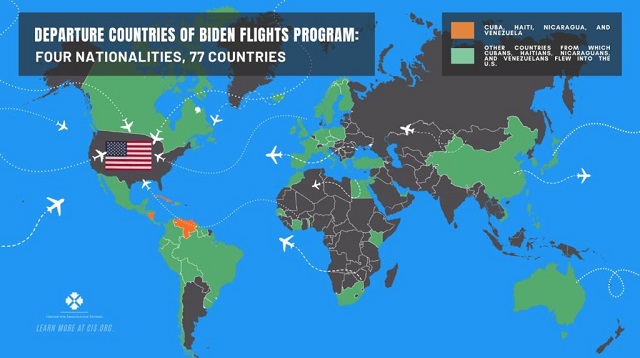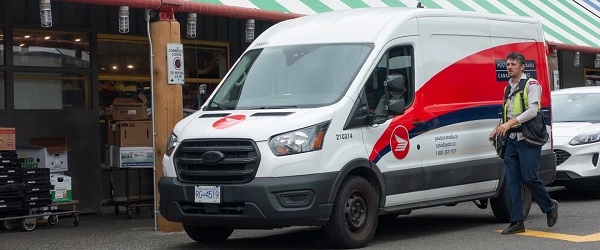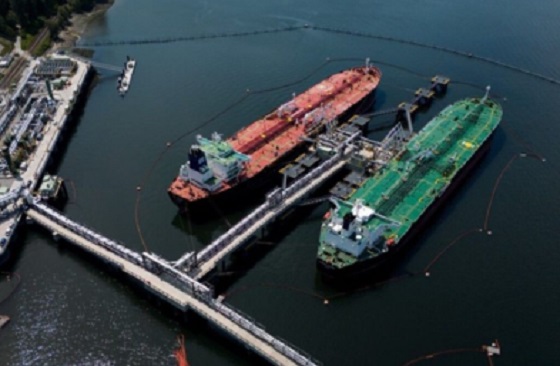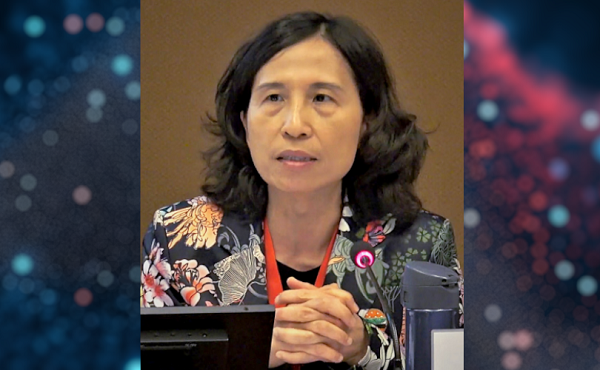Great Reset
Many Migrants in Biden’s ‘Humanitarian’ Flights Scheme Coming in from Safe Countries and Vacation Wonderlands

By Todd Bensman as published June 17, 2024 by the Center for Immigration Studies
In late 2022 and early 2023, President Joe Biden’s Department of Homeland Security launched one of the most unusual humanitarian programs in U.S. immigration history: it unilaterally began authorizing inadmissible Cubans, Haitians, Nicaraguans, and Venezuelans (thus the shorthand name CHNV Program) and their immediate family members to fly commercially from foreign countries into more than 40 American airports.
The administration has used this legally dubious program to authorize more than 460,000 ostensibly endangered nationals of those four countries to fly directly from undisclosed airports abroad into some 45 U.S. airports from October 2022 through May 2024. They are then released on temporary humanitarian parole of renewable two-year periods with work permits, during which time they are assumed (but not required) to be applying for asylum.
From this massive “rescue” program’s inception, the Biden administration has claimed that its purpose was to provide temporary U.S. sanctuary “for urgent humanitarian reasons” for those facing persecution in their native countries, and thus reduce the incentive to pass through Mexico on “dangerous routes that pose serious risks to migrant’s lives and safety” on their way to illegally cross the U.S. border.
But new information that the Center for Immigration Studies has forced from the government through litigation now reveals that, while all participants are nationals of Cuba, Haiti, Nicaragua, or Venezuela, many are flying to the United States from 73 other nations. (See the list of countries provided by DHS here.)
The departure country list casts serious doubt on whether the Biden administration has used the humanitarian rescue flights program as it was sold to the American public. In fact, the new departure country information shows that many migrants from these four nationalities have been heading to the U.S. from some of the safest, most prosperous nations on Earth, some heralded worldwide as vacation wonderlands. They could not have been suffering urgent humanitarian problems there, nor were they anywhere near dangerous migration trails.
Economic Giants and Vacation Hotspots
CHNV nationals are flying to the U.S. from Iceland and from Fiji and from Greece.
They are flying from the wealthy European Union countries of France and Germany, from Finland and Norway, from the Netherlands and Switzerland, and from Sweden and Italy. They are flying from Poland, Hungary, and the Czech Republic. Presumably, many Cubans, Haitians, Nicaraguans, and Venezuelans have reached these countries to settle and work.
The government’s list of 77 departure countries shows that, yes, ostensibly rescue-worthy Cubans, Haitians, Nicaraguans, and Venezuelans are indeed flying in from their own troubled countries to take their U.S. humanitarian protection, as most observers would presume.
But they are also getting authorizations to fly from beautiful Caribbean vacation hotspots like Barbados, the Bahamas, Jamaica, Martinique, St. Lucia. St. Kitts and Nevis, and St. Vincent and the Grenadines.
The publicly stated purposes of the CHNV program, also called the Advanced Travel Authorization (ATA) program, are at odds with the reality that many are departing from models of prosperous stability and safety, whose own residents could never possibly qualify for U.S. humanitarian protection, nor would ask for it.
“I would say this data is evidence that the parole program is not being used to help aliens flee to safety but, rather, as a secondary immigration system that has not been authorized by Congress,” said Elizabeth Jacobs, Director of Regulatory Affairs for the Center for Immigration Studies, who served as Senior Advisor in the Office of the Chief Counsel for U.S. Citizenship and Immigration Services.
“The Biden administration is likely paroling in aliens who are already ‘firmly resettled’ in safe and orderly countries but are nevertheless benefitting under the guise of urgent humanitarian or significant public benefit reasons,” Jacobs said.
Withholding the true purpose of a major government program in this way is a serious disservice to the American public, she added.
“Congress delegated DHS limited authority to use parole only for urgent humanitarian or significant public benefit reasons,” Jacobs said. “Misleading the public on the administration’s use of parole prevents voters from understanding the real impact of the administration’s policies and may prevent voters from holding the administration accountable for their abuse of the nation’s immigration laws.”
Managing Border Disorder or an Unauthorized Admissions Program?
In addition to humanitarian rescues, the government also cited a “significant public benefit” to the United States for its foreign flights program, that inadmissible aliens authorized to fly over the border into the U.S. would be less likely to illegally cross the southern border, thus lessening the chaos there.
But never disclosed until now is that the Biden DHS is also authorizing untold numbers to depart on U.S.-bound flights from many safe countries so far away from the U.S. border and Latin America that beneficiaries would never need to march the dangerous trails and crowd the U.S. border.
Cubans, Nicaraguans, Haitians, and Venezuelans the U.S. government has cleared for departure are flying in from far-flung prosperous, low crime countries nowhere near the migrant trails of Latin America or the southern border, like South Korea, Japan, Taiwan, and Hong Kong.
Some are departing from Israel. Before the war with Hamas.
They are flying from Australia.
And from the oil-rich states of Qatar and the United Arab Emirates.
The government is authorizing some number to fly in from African nations like South Africa, Morocco, and Senegal. Were any of these threatening to add their number to the southern border’s congestion?
Even Vietnam is on the departure country list.
Dispersed Around the World
Immigrants from all four nations apparently have dispersed all over the world seeking work and improved lifestyles. Perhaps things weren’t working out so well in adoptive countries when the Biden administration threw them a lifeline in the flights program. Europe is a good example.
For several years now, thousands of Cubans have flocked to illegally cross the European Union’s external borders, claiming asylum while seeking to work just as they have in the United States. Many have entered the Balkan countries through Serbia or Greece, popular illegal immigration portals of late, seeking eventual resettlement in Spain, Germany, France and elsewhere. While Greece has cracked down somewhat with reported pushbacks of illegal immigrants to Turkey, plenty of Cubans have found long-term residence in other European countries like Italy.
Venezuelans made up about 6 percent of all EU asylum applications in 2023, amounting to about 60,000, mostly in Spain. Unlike the Cubans, Venezuelans can fly to Europe visa-free for tourism and probably need not have crossed borders illegally for their asylum claims. Nicaraguans also have been known to head for Europe in increasing numbers since 2018.
While Cubans, Haitians, Nicaraguans, and Venezuelans are rarely deported from the safety and social welfare systems of Europe, perhaps some of them saw surer economic or family reunification prospects when the Biden DHS launched its flights program and decided on a lifestyle upgrade by coming to the United States.
“This information suggests that these people are firmly resettled and if they need to seek protection, then they can seek it in the countries they’re living in,” said Andrew Arthur, a Center fellow and former immigration judge. “If they are coming from anyplace other than Cuba, Haiti, Nicaragua, and Venezuela, they’re simply trading up from the third country that they’re coming from. This literally has nothing to do with asylum claims or anything else.”
The Government’s Fight for Secrecy
The CBP public affairs office did not respond to the Center’s emailed questions asking for an explanation about the surprising diversity of those rescued from often safe and prosperous departure nations. The cold shoulder is no surprise.
The obvious Grand Canyon between the administration’s public justifications for its humanitarian flights program and what it is really doing might explain why the Biden government has fought hard in court to keep the list of departure nations under wraps.
For more than a year, CBP has refused to comply with a Center for Immigration Studies Freedom of Information Act request to name them. CBP lawyers were so steadfastly opposed to their release that they forced the Center into a long and tedious lawsuit. The effort has finally produced only the names of departure countries but little else the Center requested, such as the specific departure airports and the numbers of people leaving each for American airports.
Government lawyers gave the list of 77 countries but refused during settlement negotiations with the Center to provide even a list in rank order of departure volume. In the end, the agency would only agree to disclose the 77 countries in alphabetical order.
The administration was equally secretive about which U.S. airports were receiving the immigrants, and has never agreed to release them to date, although the Center was eventually able to divine that most were flying into Florida. (See “The Florida Gateway: Data Shows Most Migrant Flights Landing in Gov. DeSantis’s Sunshine State”.) The House Homeland Security Committee, which obtained the airport locations by subpoena, later released the information.
Colin Farnsworth, the Center’s Chief FOIA Counsel, said the litigation is now settled and no more information will be forthcoming. He explained, “Although the government had no legitimate claims for withholding the foreign airports the participants of the ATA program were flying from, and their respective departure volumes, CIS determined it was in the public’s interest to quickly obtain the list of related foreign countries by settling the lawsuit, instead of allowing the government to extensively delay the release of any records through a lengthy legal process.”
Censorship Industrial Complex
Global media alliance colluded with foreign nations to crush free speech in America: House report

From LifeSiteNews
By Dan Frieth
The now-defunct ad coalition GARM shared insider data and urged boycotts of Twitter to punish non-compliance with its ‘harmful content’ standards, a US House Judiciary report shows.
A new report from the U.S. House Judiciary Committee has shed light on what it describes as an alarming collaboration between powerful corporations and foreign governments aimed at suppressing lawful American speech.
The investigation focuses on the Global Alliance for Responsible Media (GARM), an initiative founded in 2019 by the World Federation of Advertisers (WFA), which the committee accuses of acting as a censorship cartel.
According to the report, GARM, whose members control about 90 percent of global advertising spending, exploited its market dominance to pressure platforms like Twitter (now X) into compliance with its restrictive content policies.
A copy of the report can be found HERE.
The committee highlighted how GARM sought to “effectively reduce the availability and monetization” of content it deemed harmful, regardless of public demand for free expression.
Documents obtained by the committee reveal direct coordination between GARM and foreign regulators, including the European Commission and Australia’s eSafety commissioner.
In one exchange, a European bureaucrat encouraged advertisers to leverage their influence to “push Twitter to deliver on GARM asks.”

Similarly, Australia’s eSafety Commissioner Julie Inman Grant praised GARM’s “significant collective power in helping to hold the platforms to account” and sought updates to “take into account in our engagement and regulatory decisions.”

Robert Rakowitz, GARM’s co-founder and initiative lead, expressed a chilling goal in private correspondence, stating that silencing President Donald Trump was his “main thing” and likening the president’s speech to a “contagion” he aimed to contain “to protect infection overall.”

The report outlines how GARM distributed previously unavailable non-public information about Twitter’s adherence to its standards, fully aware this would prompt advertisers to boycott the platform if it failed to conform. According to the House report, Rakowitz admitted that this information sharing was designed to encourage members not to advertise on Twitter.
He went as far as to draft statements urging GARM members to halt advertising on the platform, telling colleagues he had gone “as close as possible” to saying Twitter “is unsafe, cease and desist.”
Despite the widespread impact of GARM’s actions, including what the committee describes as coerced “concessions” from platforms, internal polling circulated within GARM showed that “66 percent of American consumers valued free expression over protection from harmful content.”
Still, GARM pressed ahead with efforts to “eliminate all categories of harmful content in the fastest possible timing,” ignoring consumer preferences.
Even after GARM dissolved in 2024 amid legal challenges, similar efforts persisted.
A new coalition led by Dentsu and The 614 Group briefly attempted to revive GARM’s mission before disbanding under scrutiny. Gerry D’Angelo, a former GARM leader, reflected on the initiative’s overreach, stating, “Did we go too far in those first rounds of exclusionary restrictions? I would say yes.”
The Judiciary Committee warns that despite GARM’s downfall, the threat of collusion to stifle free expression remains.
It pledged to continue oversight to defend “the fundamental principles” of the Constitution and ensure that markets, not coordinated censorship efforts, shape the flow of information in the digital age.
Reprinted with permission from Reclaim The Net.
Business
World Economic Forum Aims to Repair Relations with Schwab

The whistleblower has always been anonymous, and it remains very suspicious that the very organization he created would turn on him after receiving an anonymous letter that they admitted may not have been credible.
World Economic Forum founder Klaus Schwab stepped down from his chairman position at the organization on April 20, 2025, amid accusations of fraud. Our computer had forecast that the WEF would enter a declining trend with the 2024 ECM turning point. This staged coup happened about 37 years after the first Davos meeting (8.6 x 4.3). From our model’s perspective, this was right on time. Now, Schwab and the WEF are working to repair ties.
An anonymous whistleblower claimed that Klaus Schwab and his wife collaborated with USAID to steal tens of millions in funding. The whistleblower has always been anonymous, and it remains very suspicious that the very organization he created would turn on him after receiving an anonymous letter that they admitted may not have been credible. Something like this would never be acceptable in any court of law, especially if it’s anonymous. It would be the worst or the worst hearsay, where you cannot even point to who made the allegation.
Back in April, the WEF said its board unanimously supported the decision to initiate an independent investigation “following a whistleblower letter containing allegations against former Chairman Klaus Schwab. This decision was made after consultation with external legal counsel.”
Now, the WEF is attempting to repair its relationship with its founder ahead of the next Davos meeting. Bloomberg reported that the WEF would like to “normalize their relationship [with Klaus Schwab] in order to safeguard the forum and the legacy of the founder.”
Peter Brabeck-Letmathe has replaced Schwab for the time being, but is less of a commanding force. Schwab’s sudden departure has caused instability in the organization and its ongoing mission. Board members are concerned that support for the organization will begin to decline as this situation remains unresolved.
The World Economic Forum’s annual revenue in 2024 was 440 million francs ($543 million), with the majority of proceeds coming from member companies and fees. Yet, the number of people registered to attend the 2025 Davos event is on par if not slightly exceeding the number of participants from the year prior.
Schwab’s departure has damaged the Davos brand. There is a possibility that the organization is attempted to rebrand after Agenda 2030 failed. The WEF attempted to move away from its zero tolerance stance on ESG initiatives after they became widely unpopular among the big industry players and shifting governments. The brand has attempted to integrate the importance of digital transformation and AI to remain relevant as the tech gurus grow in power and popularity. Those who are familiar with Klaus Schwab know the phrase, “You will own nothing and be happy.” These words have been widely unpopular and caused a type of sinister chaos to surround the brand that was once respected as the high-brow institution of globalist elites.
European Central Bank President Christine Lagarde was slated to replace Schwab in 2027 when her term ends, and all reports claimed that he was prepared to remain in the chairman role for an additional two years to ensure Lagarde could take his place. What changed seemingly overnight that would cause the organization to discard Schwab before he was due to retire?
Schwab denies any misconduct and filed lawsuits against the whistleblowers, calling the accusations “calumnious” and “unfounded.” He believes “character assassination” was the premise of the claims.
I am no fan of Klaus Schwab, as everyone knows. I disagree with his theories from start to finish. Nevertheless, something doesn’t smell right here. This appears to be an internal coup, perhaps to distract attention from the question of alleged funds for the WEF from USAID, or to try to salvage the failed Agenda 2030. Perhaps they will claim that no misconduct had occurred since DOGE did not raise concerns or there is a possibility that those behind the internal coup are concerned that Schwab’s counter lawsuit could uncover new corruption. The investigation into Schwab has not concluded, but after only three months, the WEF would like to wrap it up. It appears that the WEF does not want to welcome Schwab back; rather, they would like to ensure an amicable resolution to maintain both the brand’s reputation as well as the founder’s.
-

 Business2 days ago
Business2 days agoLatest shakedown attempt by Canada Post underscores need for privatization
-

 Business2 days ago
Business2 days agoWhy it’s time to repeal the oil tanker ban on B.C.’s north coast
-

 Alberta2 days ago
Alberta2 days agoPierre Poilievre – Per Capita, Hardisty, Alberta Is the Most Important Little Town In Canada
-

 Energy2 days ago
Energy2 days agoIf Canada Wants to be the World’s Energy Partner, We Need to Act Like It
-

 MxM News2 days ago
MxM News2 days agoUPenn strips Lia Thomas of women’s swimming titles after Title IX investigation
-

 Alberta2 days ago
Alberta2 days agoAlberta Provincial Police – New chief of Independent Agency Police Service
-

 COVID-191 day ago
COVID-191 day agoTop COVID doctor given one of Canada’s highest honors
-

 Crime2 days ago
Crime2 days agoBryan Kohberger avoids death penalty in brutal killing of four Idaho students










